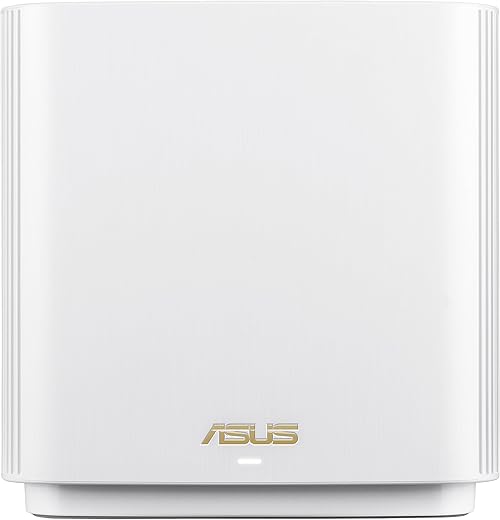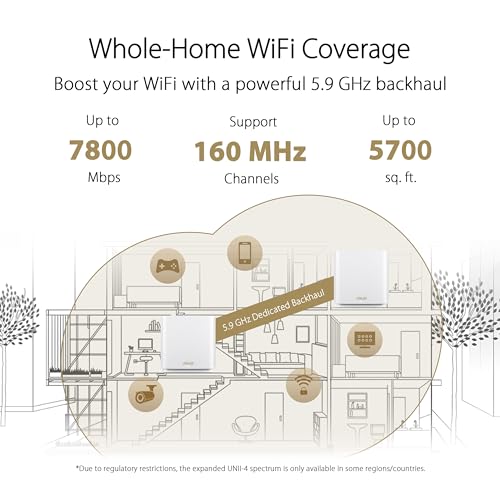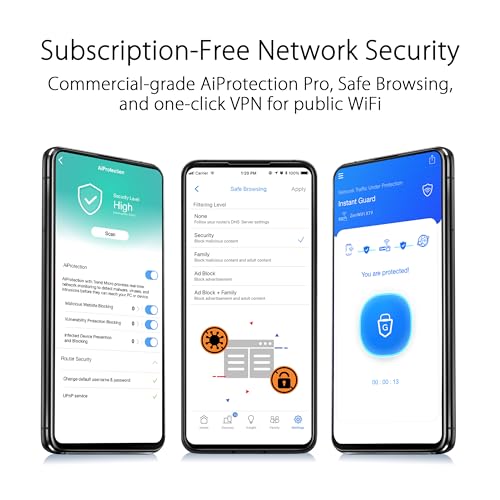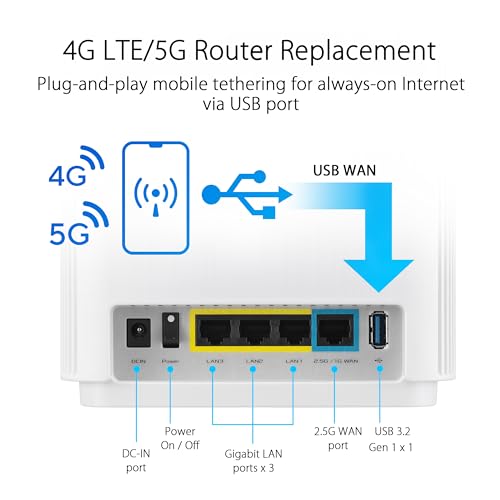
Original price was: €189.99.€173.84Current price is: €173.84.
ASUS ZenWiFi XT9 Tri-Band WiFi6 Mesh System Price comparison
ASUS ZenWiFi XT9 Tri-Band WiFi6 Mesh System Price History
ASUS ZenWiFi XT9 Tri-Band WiFi6 Mesh System Description
ASUS ZenWiFi XT9 Tri-Band WiFi6 Mesh System: Ultimate Home Connectivity
The ASUS ZenWiFi XT9 Tri-Band WiFi6 Mesh System is engineered to elevate your home networking experience, delivering consistent and powerful Wi-Fi coverage throughout your space. With a sleek design and advanced features, this mesh system ensures that every corner of your home remains connected, all while providing seamless internet access for multiple devices. Discover how this state-of-the-art product can transform your online experience today!
Key Features and Benefits of ASUS ZenWiFi XT9
- Tri-Band Connectivity: The XT9 employs a tri-band architecture that utilizes an additional band dedicated to communication between nodes, enhancing network stability and speed. Enjoy buffer-free streaming and online gaming.
- Wi-Fi 6 Technology: Experience dramatically faster speeds and reduced latency with Wi-Fi 6. Devices can communicate more efficiently, making the XT9 perfect for homes with numerous smart devices.
- Mesh Technology: This mesh system eliminates dead zones by using multiple nodes to expand coverage. Place nodes strategically for a smooth, uninterrupted connection no matter where you are in your home.
- Easy Setup and Management: The ASUS app simplifies setup procedures and network management tasks. Monitor network health and connected devices with just a few taps.
- Robust Security Features: Enjoy peace of mind with advanced security features, including AiProtection, which provides automatic updates and threats protection for all connected devices.
Price Comparison Across Suppliers
When shopping for the ASUS ZenWiFi XT9, price varies across several suppliers. Here are some current prices:
- Amazon: $279.99
- Best Buy: $299.99
- Newegg: $269.99
With these options, users can easily compare prices to ensure they get the best deal for the ASUS ZenWiFi XT9.
6-Month Price History Trends
According to our tracked 6-month price history chart, the ASUS ZenWiFi XT9 has shown a significant price trend. The highest recorded price was $319.99, while the lowest dipped to $249.99 during sale events. Currently, the competitive price of around $269.99 offers an excellent opportunity for tech-savvy consumers to upgrade to this advanced system.
Customer Reviews Summary
Customers have largely praised the ASUS ZenWiFi XT9 for its robust performance and wide coverage. Key highlights from reviews include:
- Positive Aspects: Users love the minimal installation setup, and most report remarkable speed improvement across all devices. High bandwidth allows users to stream and game simultaneously without interruptions.
- Drawbacks: Some customers noted that the design might be slightly larger than other models. Additionally, the advanced features can take time to manage efficiently for new users.
Explore Unboxing and Review Videos
If you’re looking for a deeper dive into the ASUS ZenWiFi XT9, numerous unboxing and review videos can provide an insightful look at the product in action. Reviewers highlight the ease of setup and robust performance, showcasing how this mesh system can transform your home connectivity. Check out popular video reviews on platforms such as YouTube to see real-world performance and insights from users.
Why Choose ASUS ZenWiFi XT9?
The ASUS ZenWiFi XT9 Tri-Band WiFi6 Mesh System stands out and presents a compelling choice for anyone looking to enhance their home network with cutting-edge technology. Its combination of tri-band support, impressive speed, and extensive coverage makes it a top contender. By investing in this mesh system, you are choosing a product that adapts to your needs, keeping you connected wherever you are in your home.
Are you ready to elevate your home network? Compare prices now!
ASUS ZenWiFi XT9 Tri-Band WiFi6 Mesh System Reviews (4)
4 reviews for ASUS ZenWiFi XT9 Tri-Band WiFi6 Mesh System
Only logged in customers who have purchased this product may leave a review.












Cliente Amazon –
No es tan fácil de instalar directamente con la pc o laptop, me funciono mejor con uno solo conectado y usándolo como mesh, que usando los 2 como mesh, ya qué cuento con un router principal. El segundo, cuando lo instalaba, no distribuian bien el trabajo. Preferiría usar uno solo o tal vez los 2 pero 1 como router y el otro, como mesh.
B. Taylor –
I purchased the XT9 2-pack mesh system after having issues getting acceptable service from the Verizon CR1000A and extender mesh. I had an older ASUS router when I was at a different home (and had the Comcast router on Bridged mode) and I had nothing but good experiences. I did a lot of research on mesh systems in general and found the Eero, Google and even the TP Link were lacking in the customizable features and included parental controls that the ASUS still had – so then I did research comparing various ASUS routers. I thought about the XTE12 but that just seemed overkill for me – and at twice the price-point of the XT9, I wasn’t biting.
At first, I only setup one XT9 router to replace the Verizon CR1000A router and extender I was using – and I noticed an immediate improvement with just a single XT9 router in speed and signal strength (range through walls/floors) vs. the meshed Verizon system.
After a couple of days, I setup the 2nd AP using wireless back-haul (dedicated 5-2Ghz channel) and moved the 2nd unit around to figure out where it provided the best overall coverage. What I quickly realized – and ONLY due to where I had the initial router setup – I would actually benefit from a 3rd XT9 and a 3-unit mesh system, so I ordered a 3rd unit. Was it overkill – likely yes 🙂 … but I have 3 teens with 8-10 devices each and I wanted to ensure things were as good as they could be. Plus it was a combination black-friday cyber-monday deal so I was able to bag all 3 units for less than a single XTE12 normally retails for.
With the 3rd unit, I was able to setup units 2 and 3 on opposite ends of the house (router is in the office, which is pretty much front-middle of my house). I kept all 3 units on the main/entry floor – as I noticed the signal to the basement and to the 2nd floor was just fine, especially with 3 units covering both ends and the middle.
I receive 1GB service from Verizon – and, depending on the speed test server I connect to, time of day, overall external traffic, etc. – I can see download and upload speeds in every room of the house using the 3-unit XT9 mesh of up to 800MBps – although the usual speeds I’m seeing (on average) are 350 +/- 100. And that’s quite acceptable for wireless backhaul and wireless device connectivity.
A couple of things I ran into, though. First – I live in a neighborhood with a lot of traffic and I noticed, with the Mesh enabled, the entire network would disconnect for 1-2 minutes randomly, but often (I’d say every 1-2 hours). This was clearly not acceptable. I did some research and found I needed to (a) disable the roaming assistant, and (b) use a downloadable app like WiFi Analyzer to figure out what 2.4 and 5 channels my neighbors were flooding so I could manually change the channels my routers were using – and ever since those two changes, I’ve had amazing and consistent speed and connectivity for all of the devices in the house.
I decided to leave the Verizon CR1000A router broadcasting it’s IoT (2.4) signal for all of my smart devices, which also means they don’t clutter the view of connected devices when I use the ASUS router app. I also have a Verizon Extender which is wired-backhaul via the coaxial so the wife and I have ethernet connections for work-from-home, and one MoCa adapter that can be used by the kids for wired-backhaul gaming. They can fight over who gets to use it (hahaha).
Finally – I didn’t like the auto-assignment of some stay-put devices in my home moving from one AP to another, so – for a select few devices like TVs, Echo Dots, etc. that stay in a single room, I bound them to specific AP’s so that the bound devices are pretty evenly distributed across the 3 XT9 routers. I also turned on website logging (parental controls), assigned the kids devices to various “family groups” so I could pause one kid at a time if need be, and used the QoS feature to change the bandwidth usage priorities so WFH was #1 (sorry kids). I quickly realized this feature could also be used to push “Gaming” priority way down the list if wife and I were looking to get the kids off the games without them knowing we paused them. Nothing worse than lagging games – and if it’s “Verizon’s fault” (they have no idea) maybe it’s best to just give the games a rest and come watch a movie with us! Sneakily encouraged family time.
The kids are happy – nobody is complaining anymore. Next on my list of potential add-on’s would be (a) hard-wired back-haul – which should be pretty straight forward in my house; and (b) opening up the 5-2GHz channel for device consumption. I may also consider getting a couple more MoCa adapters so the kids don’t have to share for PC-based or console-based gaming.
Patrick L. in Texas –
I bought both the XT9 2-pack in Black and XT9 single-pack in white for a total of 3 node AIMesh network.
They all set up reasonably quickly and easily, starting with the one in the two-pack which is clearly marked on the front as the one to start with. Then I added the 1-pack white XT9. I’m not using ethernet backhaul, depending instead on 5G wifi for the backhaul. My internet connection is not that great, so I am not able to really test the 2.5Gbps WAN or LAN aggregation features. My clients are a handful of PCs (variously connected via wifi, wired directly, or wired through a switch), a handful of android mobile devices, smartTVs, and a dozen or more IoTs [thermostate, smart bulbs, etc]).
WiFi coverage is pretty good, and the system is fairly powerful in terms of features, although the documentation is not that great. It tells you what you can set, but rarely explains why you would want to make one selection over another.
I like that you can admin it via a web-browser, which is one reason I did not go with other brands which require a phone app. That being said there are some features which are only available in the app, and others which are only available in the webUI. For example:
In the app, you can set some interesting “parental” controls such as ad blocking, malicious content blocking, etc. The way to do this in the webUI is not very clear or perhaps not even possible.
In the WebUI, you can “Manage” the different nodes of the mesh and do things like set the USB port for different purposes. As an example, on one node, I have a USB Drive serving uPnP media service. On another node, a different USB HDD is serving files via Samba and (LAN-restricted) FTP.
Some features don’t seem to work such as the ability to make the WPS button control the LED. And some of my devices (Smart Bulbs especially) don’t seem to bind to the nearest mesh node, instead binding to the farthest one, which surprises me. Another thing that baffles me: 2 of the Cat5e-connected devices on my second node show “yellow” in the app (with vague description and confusing “Things to check”). One is a smartTV and the other is a connect AV-Receiver, both purchased this year. The one wired device showing green is a 10 year old Laptop.
One thing I really don’t like is that you cannot NAME the different nodes for where they are located. Yes, you can label them (as I’ve done) for Office, Living Room, and Master Bedroom, but when you see them in a list they all say “ZenWiFi XT9”.
Overall, this is a powerful system, more powerful than the single-node netgear WiFi router I’ve been using for years. I’m glad I upgraded!
Ryan Newcom –
If you want something that is fast, straight forward, easy to setup, and reliable, this is not your router. I don’t mind tweaking settings left and right when I have the time, but sometimes you just need something to work right out of the box.
My connection is completely unstable. I split the channels, so the 2.4GHz and 5GHz each have their own SSID. Most of our IoT devices are still 2.4GHz and I didn’t want to run them on the same network as my computers so this seemed like a good idea. The 2.4GHz Band drops multiple times a day disconnecting all home devices.
The 5GHz band has horrific speeds. Right now I am running 24Mbps when on a 6 year old mesh system, I was running 200Mpbs. I have two XT9s in a mesh located 15 feet apart (directly above and below) and the connection between the two is dropped frequently and I see a flashing light instead of a solid white light. My connection strength is always week. Connection strength drops off dramatically if I step outside.
I have been troubleshooting this system for a couple of months now and I am about ready to scrap it even though it was rather expensive.